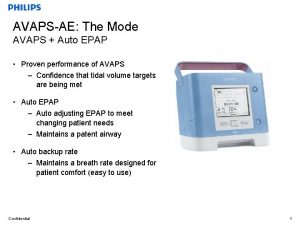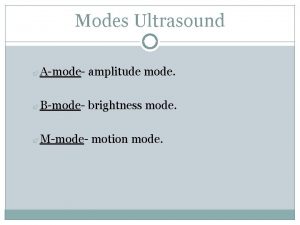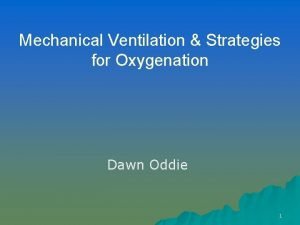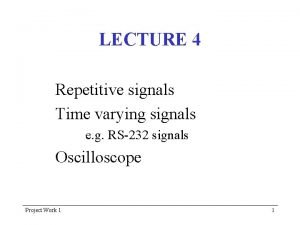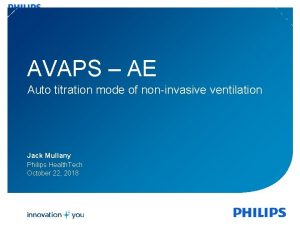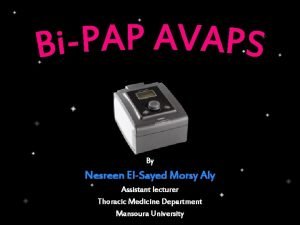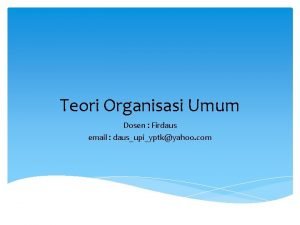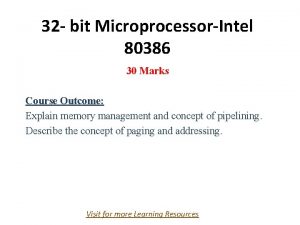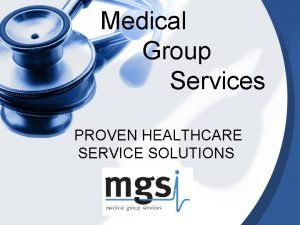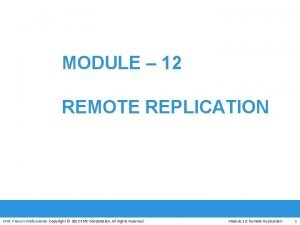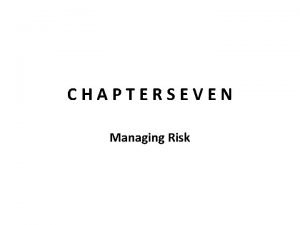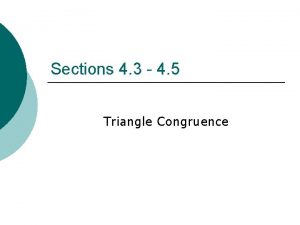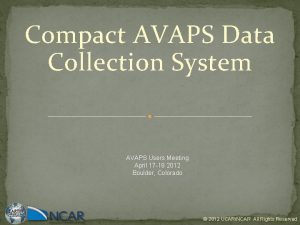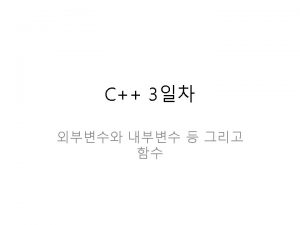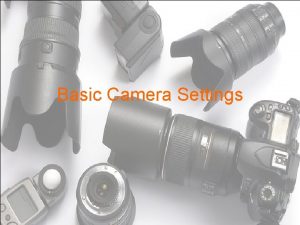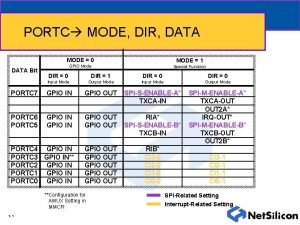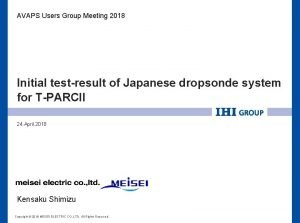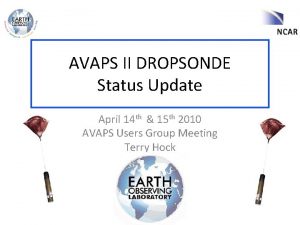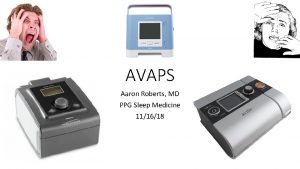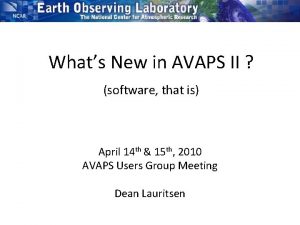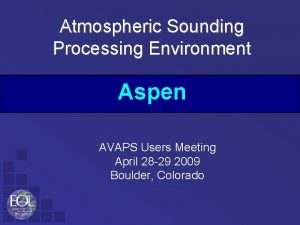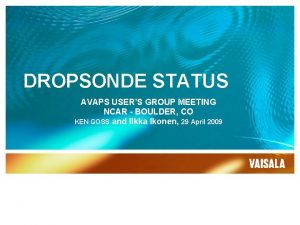AVAPSAE The Mode AVAPS Auto EPAP Proven performance



























- Slides: 27

AVAPS-AE: The Mode AVAPS + Auto EPAP • Proven performance of AVAPS – Confidence that tidal volume targets are being met • Auto EPAP – Auto adjusting EPAP to meet changing patient needs – Maintains a patent airway • Auto backup rate – Maintains a breath rate designed for patient comfort (easy to use) Confidential 1

AVAPS-AE: Auto EPAP proactive analysis Theory of Operation Device Pressure P search opt Ptherapy Pcrit search Upper Airway Resistance Illustration courtesy of Krames Medical Illustration. Confidential 2

AVAPS-AE: Auto EPAP proactive analysis Popt – Optimal Pressure Search P (High Pressure Search) Pressure opt EPAP Popt pt Po ther P P therapy pt Po P Pc rit P therapy Critical Pressure Searches crit Resistance EPAP (Low Pressure Search) Confidential P therapy Pc pt Po rit Pcrit 3

Auto EPAP today Patient type Treatment / Device Pressure support requirements OSA CPAP/REMstar Auto Low to none Cardiac Servo-Ventilation / Bi. PAP Auto. SV Respiratory insufficiency Confidential AVAPS-AE / Trilogy, Bi. PAP A 40 Dynamically applied pressure support High levels of pressure support 4

Pressure Flow Forced Oscillation Technique - FOT Forced oscillation technique (FOT) at 5 Hz, 1 cm amplitude during EPAP Confidential 5

Benefits of FOT • FOT improves detection of obstructed airways at higher pressure support levels – Not affected by high levels of pressure support – FOT measurements taken at end exhalation (10 breaths) R R Increase in EPAP by 1 cm H 2 O s Confidential 6

FOT – Flow resulting from pressure FOT signal Resulting flow Confidential 7

FOT – Patent vs. obstructed airway Patent/Normal airway Resulting flow (low resistance) Obstructed airway Resulting flow (higher resistance) Confidential 8

AVAPS-AE Maintaining tidal volume and airway patency PS max EPAP max PS min IPAP EPAP min EPAP Target Vt Resistance Confidential 9

Auto. Back-up backup rate Auto backup rate combined with the tidal volume assurance of AVAPS provides a minimum level of ventilation • Auto backup rate is near resting rate • Comfortable assistance when needed • No manual adjustments (auto-default setting) Confidential 10

Auto backup rate Moving breath rate Bpm Targeted auto backup rate is 2 bpm below avg. spontaneous rate Calculated Target auto spontaneous backup rate Minimum auto backup rate 10 Spontaneous breaths Time Confidential 50 breaths 11

Moving breath rate Bpm Auto backup rate • The reduced by Thebuffer auto is backup rateoriseliminated buffered by timed triggers. spontaneous triggers to promote synchrony • The patient will withbe theguided deviceback to the targeted backup rate Target auto backup rate Auto backup rate buffer zone 10 Timed Breaths Spontaneous Breaths Time Confidential (Night time session) 12

Auto backup rate: Patient comfort features • Comfort feature intent: Minimizes patient/device asynchrony – Rate will not exceed patient’s initial resting spontaneous rate – Machine breath delayed if patient is still exhaling – AVAPS-AE allows patient to terminate a machine delivered breath, helping to reduce gas trapping in patients with COPD Confidential 13

AVAPS-AE suggested settings OHS COPD - OSA VT target 8 -10 ml/Kg IBW 8 ml/Kg IBW Max. P 35 cm. H 2 O 30 cm. H 2 O PSMax 19 -35 cm. H 2 O 30 cm. H 2 O PSMin 14 -19 cm. H 2 O 12 cm. H 2 O EPAP Max 14 cm. H 2 O EPAP Min 4 cm. H 2 O Breath Rate Auto AVAPS Rate 2 cm/min N/A • AVAPS-AE protocol Dr. N. Hart, Dr. P. Murphy, Lane Fox Respiratory unit, St. Thomas’ Hospital London UK * • AVAPS-AE Multi Center Trial protocol l, Prof. Jean François MUIR, France Confidential

Multifaceted COPD program shown to improve care 1. Coughlin S. , Liang WE, Parthasarathy S. Retrospective Assessment of Home Ventilation to Reduce Rehospitalization in Chronic Obstructive Pulmonary Disease. J Clin Sleep Med. 2015 Jun 15; 11(6): 663 -70. Confidential

Talking Points: Patient Touch Details Reducing Hospital Readmissions in COPD Patients Patient Education at home: 1 st week after discharge: 2 home visits*and 1 phone call by RT * Visits Confidential First 30 days after discharge: Additional 6 home visits Telestation Monitoring were 30 -45 minutes in duration Next 90 days: Monthly Visits Ongoing care: Visits every 3 months

Proven to reduce readmissions In a review of 398 COPD patients* 88% reduction in hospital readmissions 1 *All receiving NIV and meeting program eligibility requirements. All subjects were admitted at least twice in the prior 12 months before enrollment. 1. Coughlin S. , Liang WE, Parthasarathy S. Retrospective. Assessment of Home Ventilation to Reduce Rehospitalization in Chronic Obstructive Pulmonary Disease. J Clin Sleep Med. 2015 Jun 15; 11(6): 663 -70. Confidential

Effective COPD Management Plans Overall Goals Inhibit disease progression Overall Goals Alleviate symptoms Increase exercise tolerance Improve health status Ultimate Goals Prevent and treat exacerbations Prevent and treat complications Moderate mortality Confidential Stable COPD Patient

Perceptions of home ventilation Past • • Invasive 24/7 support Complex devices High risk High patient Interaction Present • • Confidential Invasive – Traditional Noninvasive – Newer, simpler applications Easy to use Invasive or NIV Portable Many options for interfaces Multiple noninvasive modes and features Patient use ranges from nocturnal to full support

Diseases that benefit from NIV • Chronic Obstructive Pulmonary Disease (COPD) consequent to chronic respiratory failure • Obesity Hypoventilation Syndrome (OHS) • Muscular Dystrophies • ALS • Higher Spinal Cord Injuries • Other myopathies: Acid maltase deficiency, polymyositis, mitochondrial disorders • Neurological disorders: Spinal muscular atrophies (SMA l, lll) Neuropathies: Guillain-Barre syndrome, Multiple Sclerosis • Skeletal pathologies such as kyphoscoliosis Confidential

Identifying the right patient for NIV • COPD patients that are late stage 3 or stage 4 • Multiple COPD readmissions in the last year • Increasing pharmacological treatment with little reward • Patients that have tried/failed PAP and/or their current device is not effective anymore • Patients that have limited activity due to shortness of breath Confidential

Medicare Ventilator National Coverage Determination (NCD) Vents are covered for in-home use for: “Neuromuscular diseases, thoracic restrictive diseases, and chronic respiratory failure consequent to chronic obstructive pulmonary disease. ” Confidential

Vent Coverage Criteria Changes RAD LCD (Re) “Clarification” THEN • • Confidential Each of these disease categories are comprised of conditions that can vary from severe and lifethreatening to less serious forms. Choice of an appropriate device i. e. , a ventilator versus a bi-level PAP device is made based upon the severity of the condition. CMS distinguished the use of respiratory product types saying that RAD is “distinguished from ventilation in a patient for whom interruption or failure of respiratory support leads to death. ” In most regions, strictly enforced 24/7 usage (with breaks of 2 minutes – 2 hours) NOW “Choice of an appropriate treatment plan, including the determination to use a ventilator vs. a bi-level PAP device, is made based upon the specifics of each individual beneficiary’s medical condition. In the event of a claim review, there must be sufficient detailed information in the medical record to justify the treatment selected. ” No reference to the need for the ventilator where interruption of use would quickly lead to serious harm or death. No reference to the duration of use of the vent needing to be “continuous’ or 24/7.

Qualification Criteria Non-invasive ventilator HCPCS Code: E 0466 Confidential

Qualification Criteria – Non-invasive ventilator HCPCS Code: E 0466 • Arterial Blood Gases prove chronic respiratory failure • FEV 1 To prove the staging of the disease • Comprehensive chart notes • The physician needs to tell the story why Trilogy versus lessor device Confidential 25

Summary AVAPS-AE Average Volume Assured Pressure Support – Auto. Titrating EPAP AVAPS-AE is designed to better treat respiratory insufficiency patients (OHS, COPD and NMD) in the hospital and homecare environments • Proven performance of AVAPS – Maintains targeted tidal volume COPD / OHS • Auto EPAP – Maintains patent upper airway at comfortable pressure OSA • Auto backup rate – Applies an auto backup rate near a patient’s resting rate Confidential COPD 26

Thank You Any questions? Confidential
 Auto epap
Auto epap What is the operation for mode 0?
What is the operation for mode 0? Amplitude mode ultrasound
Amplitude mode ultrasound Epap and peep
Epap and peep Repetitive signal
Repetitive signal Avaps 모드
Avaps 모드 Disadvantages of avaps
Disadvantages of avaps Perbedaan (planning mode) dan (evolutionary mode)
Perbedaan (planning mode) dan (evolutionary mode) Mode địa chỉ tức thì là mode
Mode địa chỉ tức thì là mode 8086 vs 8088
8086 vs 8088 Difference between real protected and virtual mode of 80386
Difference between real protected and virtual mode of 80386 Gartner mode 1 mode 2
Gartner mode 1 mode 2 Focus mode and diffuse mode
Focus mode and diffuse mode Allscripts tiger misys
Allscripts tiger misys Proven amazon course for $99
Proven amazon course for $99 Wisdom will be proved right by her actions
Wisdom will be proved right by her actions Proven in use
Proven in use Emc proven professional
Emc proven professional Risk response
Risk response Can the triangles be proven congruent? if so, how?
Can the triangles be proven congruent? if so, how? Drama is a mode
Drama is a mode Cái miệng bé xinh thế chỉ nói điều hay thôi
Cái miệng bé xinh thế chỉ nói điều hay thôi Cách giải mật thư tọa độ
Cách giải mật thư tọa độ Bổ thể
Bổ thể Tư thế ngồi viết
Tư thế ngồi viết Thẻ vin
Thẻ vin Thế nào là giọng cùng tên?
Thế nào là giọng cùng tên? Thơ thất ngôn tứ tuyệt đường luật
Thơ thất ngôn tứ tuyệt đường luật
